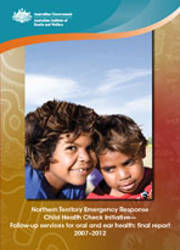Summary
This report presents information on the dental, audiology and ear, nose and throat (ENT) services funded throughout the course of the CHCI (CtG) Program. Although open to all Aboriginal and Torres Strait Islander children under 16 years living in prescribed communities, this program specifically targeted those who received referrals from their Child Health Checks. Highlights from the analyses include the following:
Dental, audiology and ENT Services
- Over the course of the CHCI (CtG) dental and audiology programs (August 2007 to June 2012) a total of 17,169 dental services were received by 9,281 children and 9,238 audiology services were received by 5,739 children.
- At the conclusion of CHCI (CtG) ENT Program (August 2007 to 31 December 2010), a total of 3,789 ENT services have been provided to 2,643 children. From 1 July 2009 to 31 December 2010, 291 ENT surgeries were performed on 283 children.
CHC referral follow-up
- At the conclusion of the CHCI (CtG) Program (30 June 2012), the majority of children who were on active CHC referral lists were followed-up. The follow-up rates were 94% for dental referral, nearly 100% for audiology referral and 97% for ENT referral.
Oral and ear health status among children who received a service at the end of program
- A large proportion of children (60%) were treated for at least one oral health problem. The most significant oral health problem was untreated caries (decay).
- Around half (51%) of children who had an audiological assessment were diagnosed with hearing loss and around a third (32%) of children were diagnosed with some degree of hearing impairment based on their better ear.
- At least one type of middle ear condition was diagnosed in around two-thirds (67%) of children who received an audiology or ENT service. The most common type of middle ear condition was otitis media with effusion (OME) (26%), followed by dry perforation (15%) and chronic suppurative otitis media (CSOM) (12%).
- Analysis of AOM, OME, CSOM and dry perforation shows the poor progress of children with these middle ear conditions. Apart from a small proportion of children who recovered from these conditions at their last checks, most children had another episode of acute infection or developed chronic conditions. These children may have developed, or be at high risk of developing, permanent hearing loss which is highly preventable.
Improvement on oral and ear health at the end of program
- For children who had more than one course of dental care, the number of children with at least one oral health problem decreased by 12 percentage points.
- The prevalence of hearing loss decreased by 10 percentage points among children who had two or more audiology checks. About 60% of children who were diagnosed with hearing impairment at their first check, showed some degree of improvement at their last audiology check.
- The prevalence of middle ear conditions decreased by 21 percentage points among children who received two or more audiology or ENT services. However, the complex nature of middle ear conditions mean some children may experience re-infection.



